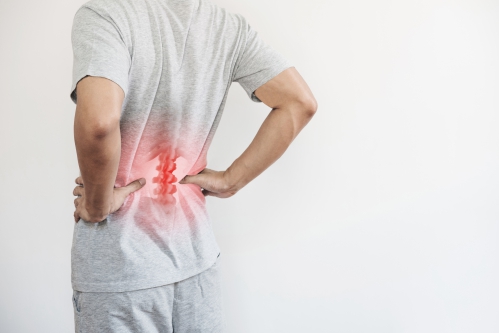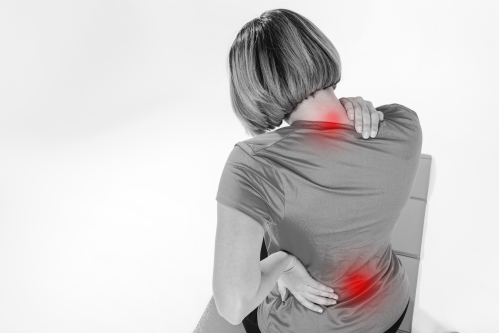Definition of back pain
Back pain is one of the most common complaint at the doctor’s office as almost everyone must have experienced back pain at least once in their lifetime. Also known as lumbago, back pain in itself is not a condition; it is actually more of a symptom of another underlying problem.
There are several medical conditions that may cause back pain ranging from the most nonthreatening to the most serious ones. It can arise if there is a problem with any structure found in the back namely the muscles, ligaments, nerves or the vertebral bodies (bones of the spine). It can also be due to problems in surrounding organs causing pain in the back and this is known as referred pain. Back pain can sometimes be severe enough to cause work-related disability and can require medical leaves.
Causes of back pain
Herniated disk
The spine is made up of bones stacked on one another called the vertebrae. In between each vertebrae there are disks called the intervertebral disks which act as shock absorbers and allow proper movement of the spine.
With increasing age, these disks can start to degenerate and rupture allowing all its content out. In doing so, it can compress nerves running along the spine. This condition is called disk herniation. Herniated disk can also occur in cases of trauma or impact in an otherwise healthy individual. This can be very painful and can even affect the legs if the bulge compresses a nerve than runs down the leg. This is commonly known as sciatica as it affects the sciatic nerve. The patient will feel pain in his/her leg along with a tingling sensation or numbness.

Spinal stenosis
When a person gets older, the intervertebral disks starts to lose water and decreases in size. This change, along with spinal osteoarthritis (breakdown of the bones of the spine), will cause a narrowing of the spinal column. This narrowing is called spinal stenosis. Inevitably, the narrowed spinal column will compress nerves leading to back pain.
Muscular causes
Muscular strain is a very common cause of back pain. This can be due to any injury to muscles, ligament or tendons. These structures help to support the spine. It is common to experience this type of back pain following a sudden awkward movement or by lifting a heavy object and twisting at the same time. This is why it is important to know how to properly position your body when lifting heavy objects as injuries can easily occur. Muscular strain can also result from vigorous sports or over activity. Incorrect sitting postures, being overweight, wearing high heels or lack of physical exercise can all strain your muscles.
Osteoporosis
This condition arises when there is thinning of bones in the body including the vertebrae. As this happens, your bones become weak and can easily break leading to fracture of the vertebrae. In turn, this fracture can give rise to severe pain as these are compression fractures. Falls or an impact to the back are common causes of fractures of the spine in patients having osteoporosis.

Other causes of back pain
- Scoliosis- a condition that some people have from birth where the spine is abnormally curved.
- Osteomyelitis- this is an infection in the bones and disks of the spine.
- Fibromyalgia- a condition that causes widespread muscle pain
- Pregnancy- the increase in weight during pregnancy can strain muscles in the back
- Spondylolisthesis- sliding of vertebra onto one another
- Stress- this should not be ignored as stress can lead to muscle tension
Progress of back pain
In most cases, the back pain will resolve within one month. Only about 10% of the cases will continue to have problems in the long term. In about 40% of patients the back pain will come back in the next six coming months. It is thus important to discuss about how to prevent its recurrence once the pain resolved. Your doctor will advise you about the precautionary measures to be taken if you are a patient at risk of having back pain. Weight loss will be promoted where indicated. Overall physical conditioning and back strengthening exercises will also help in the prevention.
Signs and symptoms of back pain

Since back pain can come from several causes, it is going to present in different ways including:
- Stiffness and dull ache along the spine
- Sharp or shooting pain in the lower or upper back following lifting, awkward movement or vigorous exercise
- Diminished range of motion and ability to lean forwards
- Inability to stand up straight without having lower back pain
It is advised to see a doctor as soon as possible if you experience any of the following:
- Pain in the presence of fever, frequent urination or having a burning sensation during urination as this may be a sign of an ongoing infection.
- If you feel like a tingling sensation, weakness or numbness in your legs, arms or groin area, you should seek medical attention immediately. This can be indicating damage to the spinal cord.
- Loss of bowel or bladder control (fecal or urinary incontinence).
- Pain exacerbated by leaning forward or by coughing may be due to disk herniation.
There are certain factors that can make your doctor think about a more serious cause of back pain. These are called “red flags” which include:
- Having a history of cancer
- Having a history of trauma
- Weight loss in the absence of diet or exercise with the intention of losing weight
- Being on medications that can lower your immune system
- Pain that wakes you up at night
- Having a history of Intravenous drug use
- Pain persisting beyond one month
- Pain getting worse despite resting

Making a diagnosis
Most of the time, the doctor will be able to come up with a diagnosis only by carrying out a physical examination. You may be required to stand and walk in front of your doctor so that any abnormalities in your way of walking can be identified. Your doctor may also need to check the range of motion of your spine, the reflexes in your extremities, strength and any loss in sensations in your legs.
If the physical examination is not enough to make up a diagnosis or if a more serious cause is suspected, further investigation will need to be done. Your doctor may order blood and urine tests, an X-ray of your spine or more advanced scans such as computed tomography (CT) scan or magnetic resonance imaging (MRI) where more detailed structures can be visualised. Bone scans allow detection of abnormal bone tissue and electromyography (EMG) allows testing for nerve conduction.
Treatment of back pain
The treatment for back pain will depend on what is causing it initially. Your doctor will advise you on the next step once a diagnosis has been established. However, there are some general actions that can be taken at home to relieve the back pain.

Resting is important in the management of back pain. During some time, it is advised to stop lifting heavy objects or twisting the body. However, staying too much in bed may be more harmful to you. It is advised to do some physical exercise or some physiotherapy. Doing some exercise in water especially can help you support some of your weight making you more comfortable.
Chiropractic spinal manipulations can be useful in cases of acute low back pain but might not be working so much in chronic cases.
Ice packs are good pain relievers and can be used in combination with medications such as acetaminophen, aspirin or ibuprofen. As soon as the inflammation has subsided, heating pads can be used for soothing effects.
In some cases, the source of the back pain may be the incorrect choice of your mattress. It is recommended to choose a medium-firm mattress.
Usually considered as last resort for chronic low back pain, surgery may be the only left solution in some cases. This is required especially in cases of disk herniation
Prevention of back pain
Some tips for the prevention of back pain include:
- Avoid high impact exercise. It is also important to have a sports coach to teach you how to do the correct form during the exercises as doing these incorrectly can lead to back strain.
- Abdominal crunches, bridges and stretching exercises can be added to your exercise schedule.
- Avoid wearing high heels.
- Adopt the correct sitting posture at your desk.
- Do not sleep on a mattress that is too hard or too soft.
- Do not lift heavy objects. If you need to lift something adopt the correct posture to do so by keeping your back straight and down and lifting with your knees while keeping your head up.
- Lose weight if you are overweight. Your doctor or nutritionist can advise you on a diet plan.
- Lumbar support belts have not been proven to be effective. It can actually make you more prone to injury. It is not recommended to use them.

Source:



